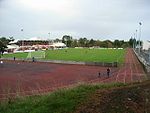Parc Trostre
Buildings and structures in LlanelliCarmarthenshire geography stubsShopping centres in Wales
Parc Trostre is a retail park in Llanelli, Carmarthenshire, Wales. The first phase of the development occurred in 1988, consisting of stores such as Tesco. In September 2008, the growing popularity of the retail park led Llanelli Town Council to express concern at the increasing adverse impact which the continued expansion of Parc Trostre is having on Llanelli town centre.
Excerpt from the Wikipedia article Parc Trostre (License: CC BY-SA 3.0, Authors).Parc Trostre
B4304,
Geographical coordinates (GPS) Address Nearby Places Show on map
Geographical coordinates (GPS)
| Latitude | Longitude |
|---|---|
| N 51.676666666667 ° | E -4.1391666666667 ° |
Address
Trostre North Retail Park
B4304
SA15 1JX , Llwynwhylwyg
Wales, United Kingdom
Open on Google Maps







